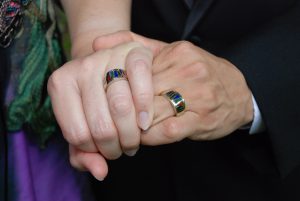Associate Professor of and Chair of Psychology Karen Gunther wanted to be an artist when she grew up.
In junior high, she decided she was better suited for science or math, but she never let her creative side wane. After knitting and sewing with both of her grandmothers almost her entire life, Gunther picked up quilting while studying biopsychology at Oberlin College.

“I wanted to somehow combine quilting with science,” Gunther said, “so I ended up studying color vision.”
Gunther says it’s fun “immersing” herself in color, and her passion for her work even extends to her personal life.
The wedding rings for her and her husband, who is also a vision scientist, were designed based on their field of study. Coral, chrysoprase, and lapis stones were used to symbolize the three cones found in the retina – red, green, and blue, respectively. Onyx lines are on the sides of their rings, which are similar to the stimuli the couple uses in their research.
After recently receiving a grant worth more than $200,000 from the National Science Foundation, Gunther’s research is about to expand.
“Vision scientists have recently determined that the retina routes the cone signals into three ‘cardinal color’ pathways: red vs. green, bluish vs. yellowish and black vs. white,” Gunter explained. “But how do people perceive colors beyond the six cardinal colors – the ‘non-cardinal’ colors?”
The grant will fund three years of research, as well as summer interns for Gunther, but it was a long process to get to this point.
Gunther applied for the grant in August 2017. In early December, she received an email from the NSF that she had not uploaded a title slide for her grant.

“This meant they were going to discuss my grant and put the slide up during the discussion,” Gunther said. “This was great news because my last NSF submission was rejected before discussion and they liked my grant enough to let me still submit the title slide!”
And though the waiting period was long, Gunther said she never stressed.
“Because the primary expectation of Wabash faculty is to teach, with secondary emphasis on research, my job wasn’t relying on the grant as it would have been at more research-intensive schools. Some researchers at other schools are on “soft” money, which means they need to get grants to get their salaries. I wanted the grant, it would be satisfying, it would fund more summer interns, but I wouldn’t lose my job without it.”